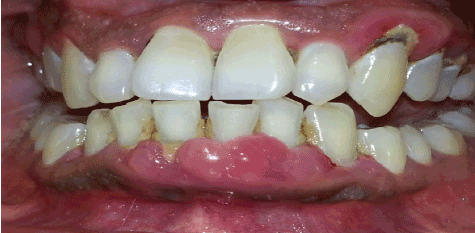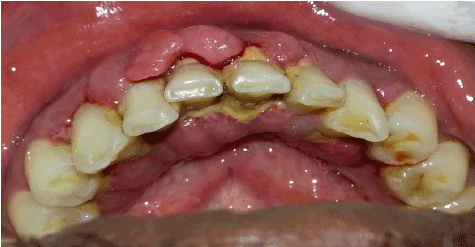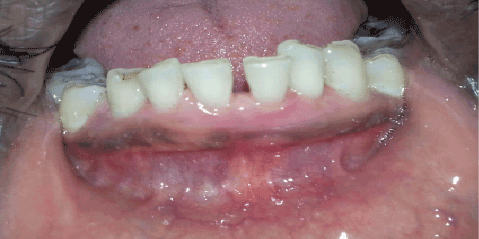
Figure 1: Inflamed and enlarged gingiva before phase I therapy

Rosamma Joseph* Jerry Mammen
1Department of Periodontics, Government Dental College, Calicut, Kerala, India*Corresponding author: Rosamma Joseph, Professor, Department of Periodontics, Government Dental College, Calicut, Kerala, India, Tel: 9446070599; E-mail: drrosammajoseph@gmail.com
Gingival enlargement is a common feature of gingival disease and represents an over exuberant response to a variety of local and systemic condition. It has been associated with an increasing number of medications such as calcium channel blockers, anticonvulsants and immunosuppressants. Gingival overgrowth can cause aesthetic disfigurement, speech disturbances and difficulty in mastication. The management of drug induced gingival overgrowth is a challenge for the periodontist, mainly due to decreased knowledge of its pathogenesis, difficulties in selection of proper treatment protocol and recurrence of the enlargement. This case report discusses the importance of non-surgical periodontal therapy (scaling and root planing along with drug replacement) in the management of amlodipine induced gingival overgrowth.
Gingival overgrowth; Amlodipine; Non-surgical periodontal therapy
Gingival overgrowth occurs as a side effect of calcium channel blockers (nifedipine, amlodipine, felodipine), anti-convulsants and immunosuppressant .Previously it was labelled as ‘gingival hyperplasia’ and ‘gingival hypertrophy’. These terms does not clearly explain our current understanding of the macroscopically enlarged, histologically altered, gingiva. Overgrowth’ is the preferred term where both increase in cellular and intercellular substances are seen.
Calcium channel blockers are used in the management of various cardiovascular conditions such as angina and hypertension. Since 1984 these drugs have been reported to be associated with gingival enlargement. Nifedipine are most frequently implicated in gingival enlargement with a prevalence ranging between 14.7% and 83% [1]. Amlodipine induced gingival overgrowth (33.3%) is comparatively less prevalent as compared to other calcium channel blockers [2]. Seymour et al were the first to report on amlodipine-induced gingival overgrowth and only few reported associations of gingival overgrowth with this drug are available in the literature [3].
A 50 year old male patient was referred to the department of periodontics, Government Dental College (Calicut) with the chief complaint of swelling in lower gums, which had been increasing over the previous six months. The patient’s medical history revealed that he was under medication for hypertension and was receiving amlodipine 5 mg/ day orally for past 6 months.
Intraoral examination revealed poor oral hygiene with high plaque score and calculus score, nodular enlargement of gingiva on the facial and lingual aspect of lower anterior teeth (Figures 1 and 2). Gingival enlargement involved marginal, papillary as well as attached gingiva. Gingiva was inflamed and soft in nature with multiple areas of spontaneous bleeding. Patient had difficulty in speech and mastication due to the overgrowth. According to the clinical index for gingival overgrowth by Eva Ingles in 1999 [4], the overgrowth was graded as III (marked overgrowth, represented by encroachment of gingiva onto the clinical crown, the contour of gingival margin is convex with a buccolingual dimension of approximately 3mm or more, probing pocket depth greater than 6mm and retractable papilla).

Figure 1: Inflamed and enlarged gingiva before phase I therapy

Figure 2: Incisal view before phase I therapy
The treatment plan consisted of oral hygiene instructions, professional oral prophylaxis and medical consultation to consider a possible change in hypertension medications. The patient had undergone phase I periodontal therapy with a full mouth scaling, root planning and intraoral irrigation with 0.2% chlorhexidine solution. After one month following phase I therapy, there was a drastic reduction in the gingival overgrowth and also marked improvement in the bleeding score, plaque score and calculus score but overgrowth was not subsided completely (Figure 3). Patient was referred to a physician and as per the physician’s recommendation amlodipine was changed to losartan/hydrochlorothiazide combination. Patient was put on a strict oral hygiene regimen and reviewed after a period of 3 months. On recall, there was complete remission of the gingival overgrowth and probing pocket depth was less than 4 mm in lower anterior teeth (Figure 4). Currently the patient is put on maintenance phase and recalled at a regular interval of 3 months.

Figure 3: One month after phase I therapy with dramatic reduction in gingival overgrowth

Figure 4: Complete remission of the gingival overgrowth after three months
Drug induced gingival enlargement has been recognized since 1939, a few months after the introduction of phenytoin as an anti-epileptic drug. Following this, an increasing number of reports of drug induced gingival overgrowth have been appeared in the literature, but the exact mechanism of induction is still not clear. The most commonly involved group of drugs are anticonvulsants, immunosuppressants and calcium channel blockers. Calcium channel blockers are a group of drugs specifically developed to assist in the management of cardiovascular conditions, including hypertension, angina pectoris, coronary artery spasm and cardiac arrhythmia. Calcium channel blockers may be classified on the basis of their chemical composition as benzothiazepine derivatives (diltiazem), phenylalkylamine derivatives (verapamil) or substituted dihydropyridines (amlopidine, felodipine, isradipine, nicardipine, nifedipine, nitrendipine, oxodipine, nimodipine and nisoldipine). The mechanism of action of calcium channel blockers is by inhibiting calcium ion influx across the cell membrane of cardiac and smooth muscle cells, thereby interfering or blocking mobilization of calcium intracellulary. The main side effect of this group of drug is from excessive vasodilatation, which manifests as facial flushing, dizziness, headache and oedema. Ramon et al. in 1984 published the first report regarding the occurrence of gingival overgrowth associated with nifedipine [5].
The pathogenesis of gingival overgrowth associated with calcium channel blockers is obscure. It has been reported that nifedipine and amlodipine may interfere with calcium transport and calcium-dependent processes. These agents may reduce cytosolic calcium levels in gingival fibroblasts and T cells, thus interfering with T cell proliferation or activation and collagen synthesis by gingival fibroblasts[1]. Lucas et al. [6] and Jones et al. [7] suggested that gingival overgrowth results from overproduction of extracellular ground substance characterized by increased presence of sulphated-mucopolysaccharides (glycosaminoglycan) and collagen, and abundant active fibroblasts. Gingival enlargement may be associated with inadequate oral hygiene and plaque accumulation [8]. It is difficult to determine whether the increased plaque accumulation preceded the gingival overgrowth or presence of enlarged gingiva is due to ineffective oral hygiene practice. Evidence suggests that plaque induced gingival inflammation exacerbates the expression of drug-induced gingival overgrowth [9]. Meticulous plaque control and the resultant reduction in inflammation will inhibit the development and recurrence of gingival overgrowth. Hancock and Swan successfully achieved significant reduction of nifedipine-induced gingival overgrowth by thorough scaling and root planning and scrupulous plaque control [10]. Lederman D et al. opined that discontinuation of nifedipine has resulted in improvement of gingival condition within one week period [11].
Management of gingival overgrowth depends on control of gingival inflammation and maintenance of effective oral hygiene with effective phase I periodontal therapy which includes scaling, root planning and with proper oral hygiene instructions. In our case we were able to achieve marked reduction in gingival overgrowth by non- surgical periodontal therapy and change of hypertension medication.
Download Provisional PDF Here
Article Type: Case Report
Citation: Joseph R, Mammen J (2016) Management of Amlodipine Induced Gingival Overgrowth by Non Surgical Periodontal Therapy-A Case Report. Int J Dent Oral Health 2(2): doi http://dx.doi.org/10.16966/2378-7090.179
Copyright: © 2016 Joseph R, et al. This is an open-access article distributed under the terms of the Creative Commons Attribution License, which permits unrestricted use, distribution, and reproduction in any medium, provided the original author and source are credited.
Publication history:
All Sci Forschen Journals are Open Access